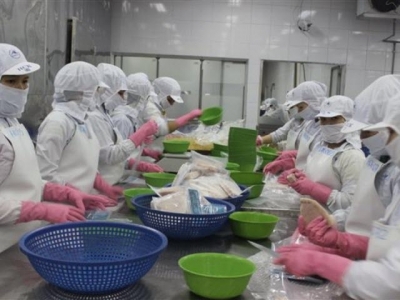Enterprises shift round to China when exporting Pangasius to US and EU grew negatively

Due to exporting Pangasius to US and EU markets having a negative growth rate, enterprises shift round to develop in China – Hong Kong and other potential markets such as: Brazil, Mexico, Saudi Arabia
Packaging fish for exporting. Photo: Thu Hòa
Shifting export market
According to information from Vietnam Association of Seafood Exporters and Producers (VASEP), by the end of November 2017, exporting Pangasius continued to grow slowly with the turnover of $US 1.62 billion, increasing by 5.3% compared to the same period last year. In particular, export value in US and EU still had a negative growth rate, so the enterprises shifted round to develop exports to China – Hong Kong and other potential markets such as Brazil, Mexico and Saudi Arabia.
In the first 11 months of 2017, the export value to China – Hong Kong market achieved $US 373.3 million, increased by 37.9% compared to the same period in 2016, accounting for 23% total export value of Pangasius. Despite the recent 3 months, the growth rate of exported Pangasius to this market has gradually cooled. This is Vietnam enterprises’ largest export market this year.
In fact, China is both a huge seafood export market in the world and a large consumption market. Moreover, Chinese customers buy a wide range of products with many segments in the market. With the advantage of having the same border, Vietnam can transport both land and sea products quickly to China, which is advantageous for export activities of enterprises.
However, China is an unstable import market with unclear customs regulations and regular changes. Therefore, it is possible in 2017, this is the salvage market for Vietnam Pangasius business, but it is difficult to forecast growth in this market in 2018.
Only 10/62 enterprises could export to US market
It’s known that US is the leading export market for Vietnamese Pangasius. In 2017, export value to the US market declined for many months due to technical and trade barriers. By the end of November 2017, the export value to the US market reached $US 319.7 million, decreased by 9.7% over the same period last year.
In recent years, the anti-dumping tax results of the administrative review sessions are high. The latest preliminary results of the 13th administrative review is three times higher than the tax results of the 12th administrative review and is even equivalent to the national tax rate, which has caused reductions in the number of exporters participating in this market. With 62 companies registered to export Pangasius to the US market but in fact, it was less than 10 enterprises joined to export and only 3 export enterprises had considerable output.
A small number of businesses that have low tariffs are facing the technical barrier of the Farm Bill inspection catfish program. Since 2/8/2017, the US Food Safety and Inspection Service (FSIS) agency has conducted food safety inspection and packaging of all shipments of Pangasius exports to the US at I- house. The examination has caused difficulties for businesses to export Pangasius into the US market due to the cost and time of re-inspection in the US.
With the flexibility of the enterprises, the export of Pangasius is not reduced too deep thanks to the flexible navigation and accelerated export to some potential markets such as Brazil, Mexico, and Saudi Arabia. At the end of 11 months, Pangasius export value to 3 markets reached $US 93.8 million, $US 93.2 million and $US 50.2 million respectively, and increased by 69.2%; 21.9% and 7.1% over the same period in 2016. Particularly in November 2017, the export value of Pangasius to these three markets increased sharply from 10.6% to 78.5% over the same period last year in 2016.
According to VASEP, 2017 is the year with many barriers in major markets for Vietnam Pangasius. Many enterprises, especially small ones, have to produce and export in moderation or loss. However, this is also the time for enterprises to restructure their business activities, improve product quality, and develop products that suit each market and requirements of importers.
Related news
 Assoc urges antibiotic control to maintain shrimp export growth
Assoc urges antibiotic control to maintain shrimp export growth It is essential to tighten controls on chemical and antibiotic residues in shrimp to maintain export growth next year
 Aquatic exports forecast to rise to US$8.5 bln next year
Aquatic exports forecast to rise to US$8.5 bln next year This year’s figure is estimated at more than US$8.3 billion, representing a year-on-year increase of 19%.
 Zeigler seeks to improve aquaculture feed, health management with new facility
Zeigler seeks to improve aquaculture feed, health management with new facility Ziegler Feeds new research facility offers research opportunities for feed development, ingredient and nutrition testing.